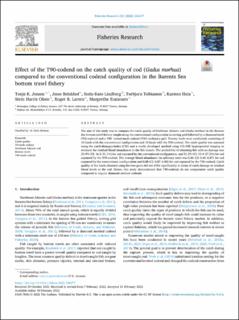| dc.contributor.author | Jensen, Tonje Kristin | |
| dc.contributor.author | Brinkhof, Jesse | |
| dc.contributor.author | Lindberg, Stein-Kato | |
| dc.contributor.author | Tobiassen, Torbjørn Inge | |
| dc.contributor.author | Heia, Karsten | |
| dc.contributor.author | Olsen, Stein Harris | |
| dc.contributor.author | Larsen, Roger B. | |
| dc.contributor.author | Esaiassen, Margrethe | |
| dc.date.accessioned | 2022-02-22T14:10:21Z | |
| dc.date.available | 2022-02-22T14:10:21Z | |
| dc.date.created | 2022-02-21T08:19:43Z | |
| dc.date.issued | 2022 | |
| dc.identifier.issn | 0165-7836 | |
| dc.identifier.uri | https://hdl.handle.net/11250/2980819 | |
| dc.description.abstract | The aim of this study was to compare the catch quality of Northeast Atlantic cod (Gadus morhua) in the Barents Sea bottom trawl fishery caught using the conventional configuration (a sorting grid followed by a diamond mesh (T0) codend) and a T90° turned mesh codend (T90) without a grid. Twenty hauls were conducted, consisting of 10 hauls with the conventional configuration and 10 hauls with the T90-codend. The catch quality was assessed using the catch-damages-index (CDI) and a newly developed method using VIS/NIR hyperspectral imaging to estimate the residual blood abundances in the fish muscle. The probability of obtaining fish with no damage was 23.4% (CI: 16.3–31.1%) for cod captured by the conventional configuration, and 21.2% (CI: 15.4–27.2%) for cod captured by the T90-codend. The average blood abundance (in arbitrary unit) was 0.86 (CI: 0.85–0.87) for cod captured by the conventional configuration and 0.88 (CI: 0.87–0.88) for cod captured by the T90-codend. Catch quality of the hauls obtained using the two gears did not differ significantly in terms of catch damage or residual blood levels in the cod. Hence, this study demonstrated that T90-codends do not compromise catch quality compared to regular diamond meshed codends. | |
| dc.language.iso | eng | |
| dc.title | Effect of the T90-codend on the catch quality of cod (Gadus morhua) compared to the conventional codend configuration in the Barents Sea bottom trawl fishery | |
| dc.type | Peer reviewed | |
| dc.type | Journal article | |
| dc.description.version | publishedVersion | |
| dc.source.volume | 250 | |
| dc.source.journal | Fisheries Research | |
| dc.identifier.doi | 10.1016/j.fishres.2022.106277 | |
| dc.identifier.cristin | 2003876 | |
| cristin.ispublished | true | |
| cristin.fulltext | original | |
| cristin.qualitycode | 1 | |
